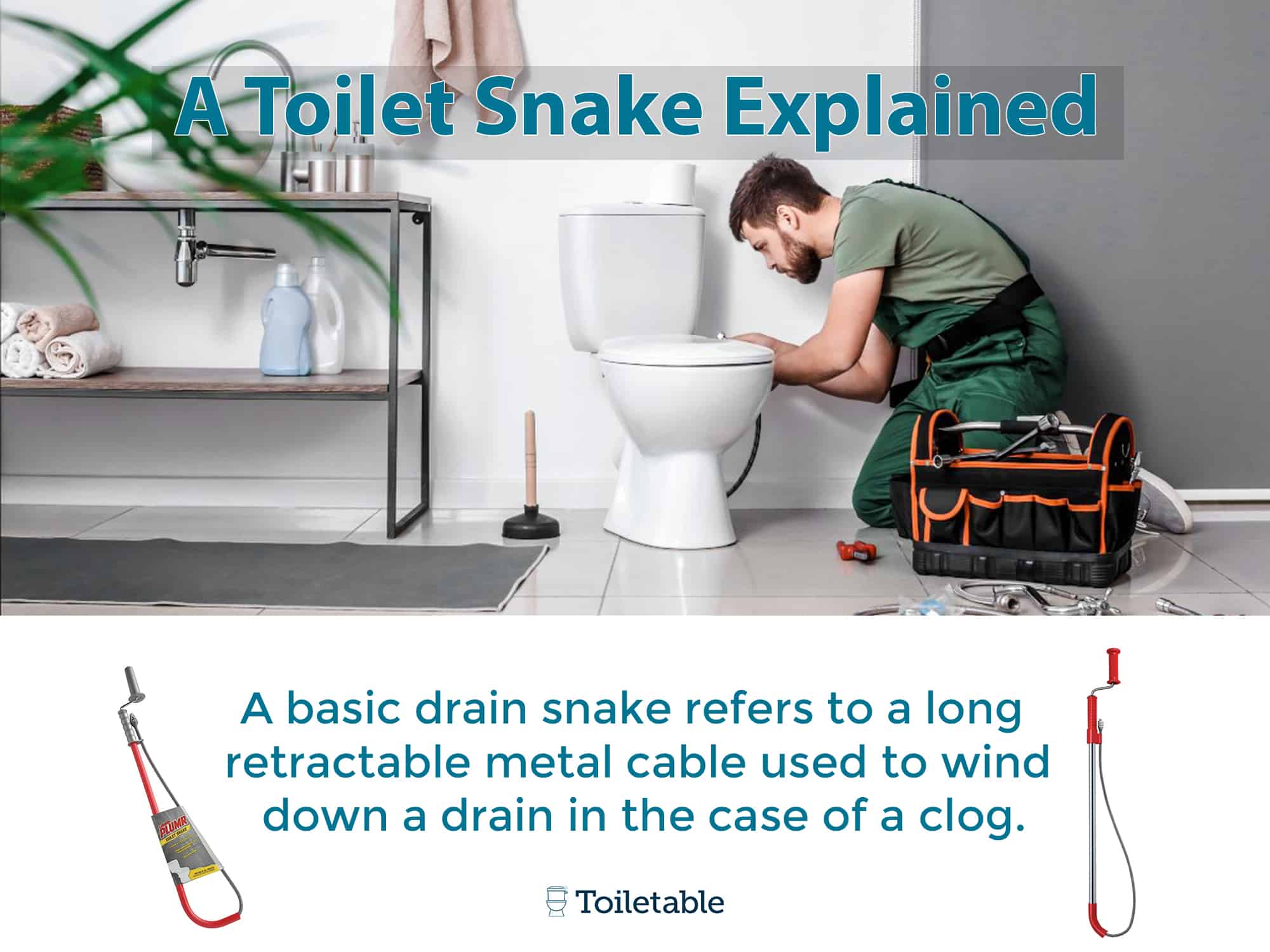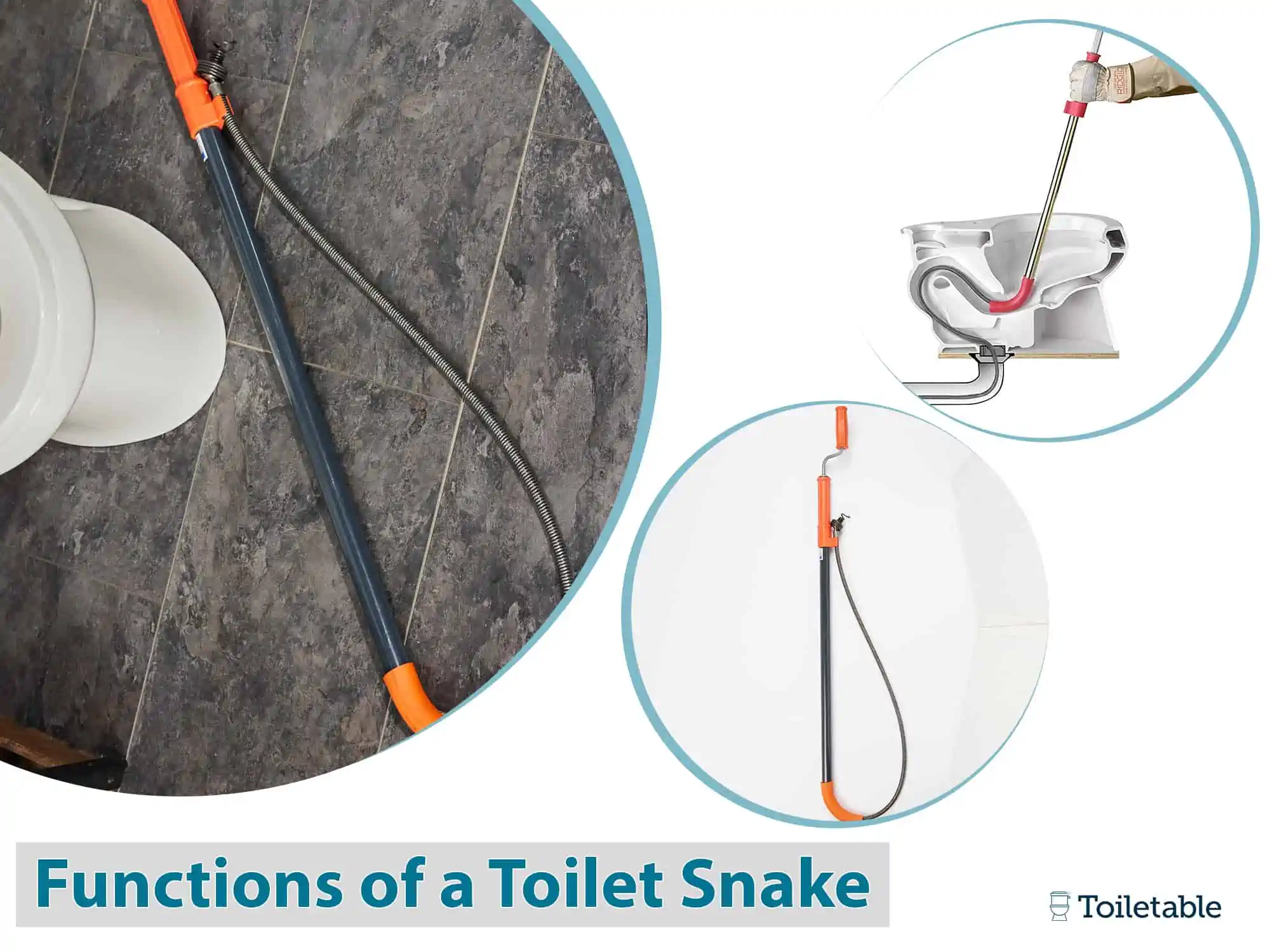There’s no feeling quite like watching the water-level rise ominously in the toilet bowl. Often unhygienic, messy, and even embarrassing, a blocked drain is a problem you want to solve ASAP.
And since you’re reading this article, we can guess that’s exactly why you’re here. Not to worry! Sometimes a stubborn clog just seems immovable no matter the amount of plunging and chemical pouring. This is when we recommend a more involved approach. And the best part?
You can do it completely on your own, no plumber necessary. You just need a little help from the toilet snake.
A Toilet Snake Explained

Not all pipes are the same, and toilet snakes are specifically designed to be used in toilet systems by either grabbing or breaking through the congested material to help loosen the blockage.
If you’re looking to purchase a toilet snake, one feature to look out for is the coating on the metal shaft of the tool. Unlike other drain snakes, toilet snakes have a distinctive protective rubber coating over the shaft to prevent scratching the toilet bowl. Toilet snakes also go by ‘toilet augers’ and ‘closet snakes’ but so long as you look for a well-made snake with a sturdy rubber coating then these aliases won’t confuse you!
Toilet snakes are a common tool readily available in most hardware stores and online. They’re generally quite affordable, so it’s easy to have a basic toilet snake on hand in case of emergency. However, if you do want to invest in a drain auger or another more powerful tool, be prepared to spend more.
Functions of a Toilet Snake

Your toilet’s drain, just like any other drain, is prone to clogging. Have a look under your sink; you’ll likely see the pipe that carries away waste, particularly noting the pipe’s bent shape. This crucial bend is referred to as the p-trap, and this shape is also integrated into the porcelain making up your toilet.
When your toilet works as expected, the force of the flush pushes all waste smoothly through this pipe. Everything you flush must go through this pipe, which is why larger objects can get stuck and prevent your toilet from draining properly.
The most common causes of toilet clogs include excessive toilet paper, waste, or any other object that’s unable to break down or too large to flow through the pipes.
If you are attempting to unclog your toilet, keep in mind that you’re basically trying to move the blockage material through the p-trap bend. When blocked, you’ll need to manually jostle the waste and clear the blockage, which is where the toilet snake comes in handy.
Types of Toilet Snake

Snakes vs. Augers
Augers and snakes? Snakes and augers are often confused for one another or lumped together as the same tool. True, they are two very similar drain-clearing tools, but they have important differences. There are various types and sizes of augers for different drain needs but all augers act in the same way – boring through a blockage, loosening and dispersing the waste, while snakes grab and pull the blockage out.
All of these options mean the toilet snake is not the only tool out there to unclog your toilet. However, the toilet snake is probably your best bet. Let’s take a look at exactly what these augers do to understand why we recommend the toilet snake:
Cable Auger
Also known as drain augers, cable augers are a good general auger to have in your home. You can use a cable auger on a sink or toilet; however, you risk scratching your toilet bowl on the uncovered metal rod. Cable augers have a corkscrew-shaped hook at the end of the cable which can be firmly twisted into the blockage and then used to haul it out.
Flat Tape Auger
Flat tape augers are similar to cable augers in how they work but the design is very different. Flat tape augers have a sharp tip and a more rigid flat cable instead of a hook and hose shape. The difference in design is because flat tape augers are very small and are only made for pipes with maximum diameter of 2 inches – a lot smaller than your toilet. In these small pipes, pushing is preferable to pulling, and the spear loosens and pushes the clog along the pipe to clear it.
Power Auger
Power augers are the alternative to manual augers like the cable auger. The power auger typically has a built-in motor or another power source which means you just have to feed the cable into the drain and let the auger do the rest. This is faster than a manual, but power augers are more expensive and more difficult for beginners to use.
Rocket Nozzle Auger
Rocket nozzle augers. The name alone gives it away, but these augers are pretty serious pieces of equipment. Not recommended for non-professionals, rocket nozzle augers are only used in commercial application and by licensed plumbers. Not to mention they’re much pricier than our other examples… We’re thinking that’s a little excessive just for a toilet.
Toilet Auger and Snake
Here it is. This is what you’ve been waiting for: the toilet snake.
We know now that all pipes aren’t the same. Cable augers scratch the porcelain, flat tape augers are too small, power augers are pricy, and rocket nozzle augers might destroy your toilet entirely. Toilet snakes are the perfect solution.
Toilet snakes are shorter than other augers to perfectly fit your pipes and come with a protective rubber coating over the metal rod to protect your bowl. The toilet snake either grabs or breaks through the pipe congestion, loosening it all. When a pipe is congested you can either break the blockage, push it through, or pull it back. Pushing a blockage is risky if you don’t know your pipe system or are inexperienced. Pulling the clog out is a guaranteed success – the obstruction travelled along the pipe to get there so you know it can fit back up. Designed to pull out, the toilet snake ensures that the obstruction is removed which makes them very beginner friendly.
How to Snake a Toilet (DIY Steps)
Snaking a toilet may sound intimidating but the process is actually quite simple. The only things you’ll need are a pair of rubber gloves and the toilet snake itself. But we don’t exactly recommend wearing your nicest outfit either.
Here are the five simple steps that you should follow (and a helpful YouTube video for a more visual explanation):

Step One: Insert the Toilet Snake
Take the toilet snake and insert the metal cable into the toilet bowl. Make sure that the snake goes all the way down into the drain.
Step Two: Turn the Toilet Snake
Crank the handle in a clockwise motion to push the cable deeper into the drain. Following the curve of the drain, keep cranking until the whole cable has made it through. If you feel the resistance of the clog, let the crank reset before continuing to turn. Repeat this as many times as necessary.
Step Three: Slowly Remove the Toilet Snake
Turn the handle counterclockwise to gradually retract the cable. Don’t go too fast: the goal of this step is to either pull out or break up the clog with the snake’s motion, not to soak everything within splash-range!
Step Four: Test the Toilet with a Flush
When the cable has retracted fully you should have successfully removed the clog. You’ll notice the water level going back to normal in the bowl. To really confirm it, take a test flush. If your toilet flushes without a problem and drains like normal then it’s official!
Step Five: Clean-Up
After you’ve confirmed that the toilet is back to normal, clean your toilet snake and safely store it away. We recommend cleaning your toilet snake with a hard-wire brush and warm, flowing water.
And in five easy steps, you’ve successfully resolved your blocked drain issues all on your own! Who needs a plumber with you around?
Preventative Measures Against Clogging
Now that you have solved the problem, you don’t want to have it again. There are a few ways you can stop another clog from happening in the future:

The Flush
Only flush things that are meant to be flushed. For instance, we all know that toilet paper is specifically made to break down when you flush it down the toilet. But other bathroom items like cleaning wipes, sanitary products, and paper towels break down very slowly or not at all. These ‘unflushables’ should be thrown in a waste bin instead.
Take Cover
Another way to prevent clogs is the positioning of the toilet seat and cover. Any foreign object that falls into the toilet can easily lead to blockages. To avoid this, always keep your toilet seat and cover down to cover the drain. This not only stops things from falling into the toilet but is also more hygienic.
Drain Cleaners
Another clog-causing culprit is chemical drain cleaners. Over time certain chemical cleaners can build up in your drain and damage the bowl and pipes. Try avoiding these harmful products and instead look for cleaners marked as fully safe for your toilet and drain instead. Many of these options are not only safer for your toilet but also your home, your children, and the environment.
Eyes Open
Identifying and resolving any toilet issues early on can save you a world of trouble. If you notice that your toilet has trouble flushing or the water level is lower than normal, something could be wrong. If you can identify the problem early on you may not even need to use your snake! A plunger or a safe chemical solution could be enough to nip the problem in the bud.
Care
Finally, the most important way to keep your toilet clog-free is through regular maintenance and TLC. Keeping both your toilet and the pipes clean minimizes the risk of material build up over time. We recommend that you clean your entire system at least once or twice a month for the best results.
Buying a Toilet Snake
Toilet snakes are a very common tool and you can find them in most hardware shops or online. They’re also pretty affordable so it’s easy to have a basic toilet snake around for when you need it. Remember the snake/auger confusion? Well toilet snakes also go by ‘toilet augers’ or ‘closet snakes’ which can get confusing. The most important thing to look out for when buying though is a sturdy rubber coating because an exposed metal shaft can damage your toilet. So no matter the alias, you know enough about drain snakes now to make a good choice for your toilet.
Our Opinion
So successfully snaking a toilet isn’t as tough as it sounds. After your first time you’ll easily snake any future stubborn clogs and avoid calling a plumber for an issue you can resolve all on your own. Remember our preventative measures and you’ll be unstoppable!
